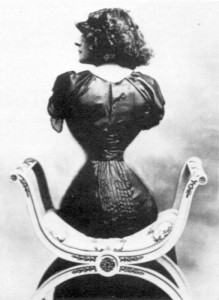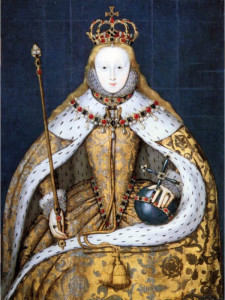Lesson 44
Notes on the Body and Fashion
What we would consider overweight has, in the past, signified wealth and power, as in the famous images of Henry VIII. At a time of widespread malnutrition, thin would represent poor and weak. (As it still does in many so called ‘third world‘ countries in the world today). In contradiction in the developed west today, obesity is seen as a condition of the underprivileged.
Henry’s diet, with its emphasis on quantity and meat, would be considered very unhealthy these days. The Tudors did not have a word for vegetables, although there was something called salad. The servants who worked in the kitchen would eat potage, a thick porridge like stew made with oats or cornmeal and vegetables, sometimes containing small amounts of meat. This potage was much more healthy eating than the killer food at the high table. (The Tudors were also drunk most of the time, as water was mostly undrinkable, they drank beer and wine. In Europe fermentation cleansed the water, whilst in China they boiled the water for tea).
Alternatively, with the fashion for small waists, the use of corsets to achieve the desired effect – even in extreme cases the removal of the lower ribs – requires extreme transformations of the female body. Corsets caused miscarriages, paralysis rheumatism and dyspepsia, impaired circulation, liver and kidney problems and distorted bones. Interestingly eating disorders were present amongst women in the 16th century onwards and not just the province of the 20th and 21st centuries.
Polaire, a French actress famous for her wasp waist.
Lead white face. Elizabeth 1.
The Elizabethans painted their faces and blue veins, dangerously, with white lead, all to emphasise that they did not go out in the sun. Peasants worked in the sun and the white skin of the aristocracy made it clear that they did not work but had a life of leisure. Similarly and paradoxically, Coco Channel’s introduction of the sun tan signifies the same, that of wealth and leisure. A tan says that you do not work in a factory or office but can lie in the sun doing nothing all day. This healthy image of the sun tan is beginning to change with well-being issues around melanomas and skin cancer. People are now mocked if they are obsessively tanned, the Caucasian might be returning to a whiter skin as a signifier of responsible living.
Aristocrats grew their nails long, which also represents that the owner does no manual labour, or use their hands in any craft or trade. A fashion that persists today amongst women, an image that aspires to a life of leisure, pampering and decadence.
The popularity of bodily modification has waxed and waned in Western culture. The ancient art of tattooing grew with increased contact with non-European cultures. In the 19th century it was largely associated with sailors, but in 1870 also became popular with public school boys and amongst some members of the upper classes including British royalty, with European royalty taking up the British royal lead. Tattooing can be found amongst the lower classes but the middle class rejected it. Along with body piercing, (other than just earlobe), tattooing gained subculture status in the mid 1970s, instigated by Punk and from this anti-establishment position, in 1990s it has spread to the mainstream forms of bodily decoration.
This entry was posted on Wednesday, May 10th, 2017 at 8:51 am
You can follow any responses to this entry through the RSS 2.0 feed.


